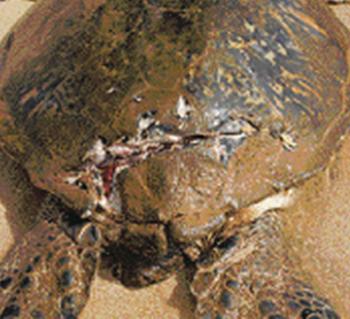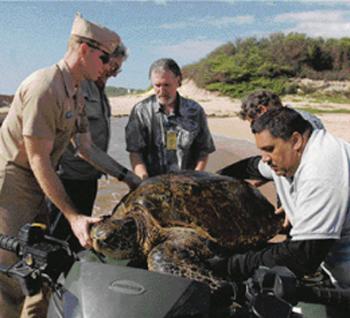MANA — Don Heacock has two words for ocean boaters in areas known to be frequented by sea turtles: “speed kills.” Speeding boats and their razor-sharp propellers are responsible for four or five “vessel-related turtle deaths this year” in Kaua‘i
MANA — Don Heacock has two words for ocean boaters in areas known to be frequented by sea turtles: “speed kills.”
Speeding boats and their razor-sharp propellers are responsible for four or five “vessel-related turtle deaths this year” in Kaua‘i waters, said Heacock, aquatic biologist with the state Department of Land and Natural Resources Division of Aquatic Resources.
That number nearly increased by one last week when a female green sea turtle found injured and bleeding in waist-deep water off the U.S. Navy Pacific Missile Range Facility at Barking Sands was rescued by humans.
Her injuries are consistent with contact with a boat propellor, Heacock said.
The turtle, weighing in excess of 300 pounds, was sent to O‘ahu, endured around three hours of surgery to repair her cracked shell, or carapace, and other injuries, and released back into the wild last week, said Heacock.
Sea turtles, which rest and bask on the ocean’s surface, are regularly seen in shoreline areas where coral, reefs and rocks provide ample food sources and shelter from their main predators, tiger sharks, Heacock said.
“Remember, these are shoreline animals. The moral of this story is speed kills,” and boats going too fast to be able to avoid these creatures likely caused the deaths and injury, he said.
Heacock said the injured female likely heard or felt the approaching boat, but not in enough time to dive out of harm’s way.
The turtle suffered one propeller strike near the middle of her carapace and the most-damaging blow was nearer to the bottom of her shell, near her pelvis, which severed the top of the carapace and cut through the turtle’s spinal column.
When rescuers reached her she was bleeding and had they not brought her quickly to shore she likely would have become a meal for tiger sharks, who can detect blood in the water from 10 miles away, Heacock said.
Stainless steel pins, epoxy and a fiberglass sheet were used to fix her carapace and veterinarians were also able to repair her internal damage, he said.
After giving her antibiotics and seeing that she was “full of energy” after the operation, a decision was made that it would be best for the turtle to get back into the water, feeding on her own, in her natural habitat. So she was released off Kane‘ohe, O‘ahu, Heacock said.
“In animals, it’s adult females that count, so they (veterinarians) went to great efforts to save this turtle,” Heacock said.
And, since the endangered animals are very territorial, Heacock and others are hopeful this one will return to Kaua‘i, where she will be very recognizable with a large orange mark and tagged fins.
“We’ll be watching” for her, Heacock said.
Tom Clements, PMRF spokesman, who had a hand in the rescue at Nohili on the base, has affectionately nicknamed the turtle “Ding,” as veterinarians on O‘ahu used fiberglass to repair a portion of her damaged shell, as surfboard repair people use fiberglass to fix dings in surfboards.
According to Clements, the turtle was discovered near the Nohili shoreline at PMRF, initially by Jason Shimauchi of the U.S. Department of Agriculture Animal and Plant Health Inspection Service, assigned to the base primarily for the purposes of investigating aircraft collisions with birds.
Shimauchi and others monitored the turtle, which had injuries consistent with contact with a boat propellor, until the arrival of Heacock, Clements said.
The turtle was so heavy, over 300 pounds, that it took five men to carry her, including Clements and base Commanding Officer Capt. Aaron Cudnohufsky, moving it first out of the shorebreak and eventually onto a PMRF security all-terrain vehicle for transport down the beach, up the berm and to Heacock’s waiting state truck.
Initially, Clements and Cudnohufsky were there only to monitor the situation, according to Clements. But when Heacock said the turtle weighs around 350 pounds, it was all hands on shore to lift the critter.
She is estimated by Heacock to be between 50 and 80 years old. The only way to estimate age of a living turtle is by weight, he said.
After being monitored by Heacock on Kaua‘i overnight, the turtle was airlifted to O‘ahu on Aloha Air Cargo, in surgery for three hours on O‘ahu, then released back into the ocean off Kane‘ohe, O‘ahu.
Clements has high hopes that Ding will eventually make her way back to Nohili, a popular place for turtles to haul out for rest. Heacock said it is likely she will make her way back to Kaua‘i, and even at age 75 or 80, is still capable of reproducing.
According to Heacock, the healthy female turtle has no known tumors or other medical problems.
• Paul C. Curtis, staff writer, can be reached at 245-3681 (ext. 224) or pcurtis@kauaipubco.com



